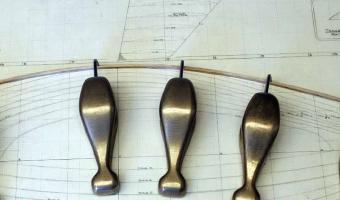
You may not realize that splines were once physical things. In an era prior to CAD and large-format printing, when draftsmen needed to lay out full-sized curves—for boatbuilding, airplane manufacturing and the like—this is how they did it. To be clear, the “spline” is the actual strip of wood being bent and held in place. The things holding it in place are called spline weights, or colloquially, “ducks” or “whales.” They weigh about five pounds apiece. […]
You may not realize that splines were once physical things. In an era prior to CAD and large-format printing, when draftsmen needed to lay out full-sized curves—for boatbuilding, airplane manufacturing and the like—this is how they did it. To be clear, the “spline” is the actual strip of wood being bent and held in place. The things holding it in place are called spline weights, or colloquially, “ducks” or “whales.” They weigh about five pounds apiece.
Physical splines may date back from the 1700s:
The classical “spline”, a wooden beam which is used to draw smooth curves, was probably invented then. The earliest available mention of a “spline” seems to be from 1752.
It’s unclear when ducks (spline weights) started being used. There is an extensive demonstration of ducks by a naval architect, starting at 20:35 in this video: https://www.youtube.com/watch?v=6n14fiLLyDQ&t=1234s.
Sources:
First quote from Rain Noe (2016) When Splines Were Physical Objects. (archived version) Second quote from Gerald Farin (2002) A History of Curves and Surfaces in CAGD. (archived version) Photo by Rain Noe.
Added by: Pierre Dragicevic.
Category:
Enabling technology
Tags:
physical computation, splines, ducks, lofting